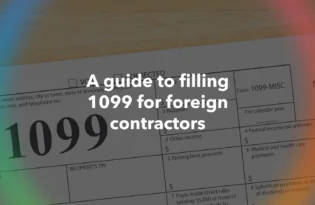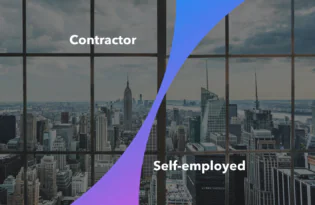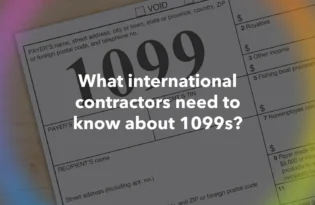What is a contractor NDA?
You want to ensure that your IP and proprietary software stay safe? You need a contractor NDA that stands up to scrutiny. Learn more about this in the article

A contractor NDA is a privacy agreement provided to independent contractors upon hire (or, in some cases, during intensive interviews) that establishes a confidential relationship between them and the employer.
In effect, this prevents them from discussing, disclosing, or misusing any confidential information outside the scope of work established in their contract.
The following article provides a sample contractor NDA with commentary to provide business owners with an idea of the key clauses to include, how to present them, and additional legal considerations when issuing them.
What does a sample contractor NDA look like?
The following acts as a sample contractor NDA. In addition, we provide additional commentary for each section listed, as well as alternate terminology for a mutually binding (as opposed to unilateral, where restrictions are placed only on the contractor) contract.
| This Non-Disclosure Agreement (“Agreement”) is entered into as of [Date] by and between [Company Name] with offices at [Company Address] (“Company”) and [Contractor Name] residing at [Contractor Address] (“Contractor”). Company and Contractor may each be referred to as a “Party” in this Agreement. | Any future references to the parties mentioned here should use the same names to avoid confusion. |
| 1. Purpose. [Company] wishes to disclose certain confidential information to [Contractor] for [describe the project or purpose, e.g., “evaluating and performing services for Company”]. This Agreement is intended to prevent unauthorized use or disclosure of the confidential information. | The scope of work should be specifically stated here. Avoid vague terminology. If Mutual: Say that “both parties may disclose confidential information” in connection with the defined purpose. |
| 2. Confidential Information. “Confidential Information” means any non-public information that Company discloses to Contractor, either directly or indirectly, in writing, orally, or by inspection of tangible objects, and that is either marked or identified as confidential (or would be understood to be confidential by a reasonable person under the circumstances). This includes, without limitation: Business plans Financial records Customer or client data Trade secrets Technical designs Software source code Proprietary tools, know-how Any other information that is not generally known to the public. Confidential Information also includes any notes, analyses, compilations, or other documents prepared by Contractor that contain or are based on [Company’s] confidential information. | Make confidential listings specific to the job responsibilities listed. Making “everything” confidential weakens your case later on. If Mutual: Swap in language like “each Party’s Confidential Information” instead of just “the Company’s.” |
| 3. Exclusions. Confidential Information does not include information that:* (a) is or becomes publicly available without breach of this Agreement by Contractor; (b) was already known to Contractor before disclosure by Company, as evidenced by written records, and not through a prior confidentiality obligation; (c) is lawfully received by Contractor from a third party who is not bound by a confidentiality agreement with Company; (d) is independently developed by [Contractor] without use of or reference to [Company’s] Confidential Information; or (e) is required to be disclosed by law, regulation, or court order, provided that Contractor gives prompt written notice to Company (if legally permitted) so Company can seek a protective order or otherwise limit the disclosure. | No changes needed for a mutual contract |
| 4. Non-Disclosure and Limited Use. Contractor shall hold and maintain all Confidential Information in strict confidence. Contractor will not, without [Company’s] prior written consent, disclose any Confidential Information to any person or entity except to Contractor’s own team members or professional advisors who need to know it for the Purpose stated above and who are bound by confidentiality obligations at least as protective as this Agreement. Contractor agrees not to use the Confidential Information for any purpose other than to perform Contractor’s services for Company. Contractor shall not copy or reproduce Confidential Information, except as necessary for the Purpose, and shall affix to any copies all confidentiality notices or legends that appear on the original. | “Silent loopholes” are unintentional gaps in the contract that pose a potential for breach. These might be a lack of limitations on internal sharing, instructions on HOW data is to be protected, or not restricting future use of IP after a project ends. If Mutual: Change the language to apply to both parties as receiving parties. |
| 5. Protection of Information. Contractor agrees to take all reasonable measures to protect the secrecy of and avoid disclosure or unauthorized use of the Confidential Information. These measures shall be no less protective than those [Contractor] uses to safeguard its own confidential information. If Contractor becomes aware of any misuse or unauthorized disclosure of Confidential Information, Contractor will promptly notify [Company]. | Clarify “reasonable measures” where necessary for the job (i.e., encryption, password protection) If Mutual: Replace “Contractor” with “Each Party” and make it mutual in structure. |
| 6. Return of Materials. Upon completion of the Purpose or at any earlier time upon [Company’s] request, Contractor will immediately cease using Confidential Information and return or destroy (at [Company’s] option) all materials embodying Confidential Information, including any copies, notes, or derivations, as per instructions provided by Company. If [Company] requests destruction, [Contractor] shall certify in writing that such materials have been destroyed. Notwithstanding the return or destruction of materials, Contractor will continue to be bound by the confidentiality and non-use obligations in this Agreement for the time periods stated in Section 7. | If Mutual: Have both parties agree to return or destroy the other’s confidential materials. |
| 7. Term. This Agreement is effective as of the date first written above and will continue in effect until the earlier of: (i) [X years] after the end of Contractor’s services for Company, or (ii) the date Company sends Contractor a written notice releasing Contractor from this Agreement. However, [Contractor’s] duty to protect Confidential Information that is a trade secret under applicable law shall continue for as long as such information remains a trade secret.** | Average terms are between 2-5 years. Avoid perpetual terms, especially for non-trade secrets. If Mutual: State that both parties’ obligations survive for the same period. |
| 8. Remedies. Contractor acknowledges that any unauthorized use or disclosure of Confidential Information may cause irreparable harm to Company, for which monetary damages may be inadequate. Therefore, [Company] has the right to seek injunctive relief (e.g., a court order to stop the breach or prevent further disclosure) in addition to any other rights and remedies available at law or in equity, in the event of a breach or threatened breach of this Agreement. [Contractor] may also be liable for monetary damages and reasonable attorney fees in any action to enforce this Agreement in which [Company] prevails. | There is no need to detail punishments; just make it clear that there will be punishments for violations. If Mutual: Both parties can reserve the right to seek injunctive relief for breaches by the other. |
| 9. No Rights Granted. Nothing in this Agreement is intended to grant Contractor any rights (by license or otherwise) in or to Company’s Confidential Information, except the limited right to use such information for the Purpose. All Confidential Information remains the sole property of [Company]. Contractor expressly acknowledges that no other rights, including intellectual property rights, are conveyed to Contractor by this Agreement or by any disclosure of Confidential Information. | If you are disclosing IP rights (e.g., code, designs, plans), this is essential to detail. If Mutual: Each party should retain its respective rights and IP. |
| 10. Defend Trade Secrets Act Notice (U.S. Federal Law). Notwithstanding any other provision of this Agreement, under the Defend Trade Secrets Act of 2016, [Contractor] cannot be held criminally or civilly liable for disclosing a trade secret: (A) in confidence to a government official or an attorney solely for the purpose of reporting or investigating a suspected legal violation, or (B) in a complaint or other court filing made under seal (i.e., filed under seal so it is not public) in a lawsuit alleging retaliation for reporting a legal violation. In the event Contractor files a lawsuit for retaliation by Company, Contractor may disclose Company’s trade secrets to their attorney and use the trade secret information in court if Contractor files any document containing the trade secret under seal and does not disclose the trade secret except pursuant to court order. | If Mutual: No changes needed—it applies to either party as a potential whistleblower. |
| 11. Miscellaneous. Governing Law: This Agreement shall be governed by and interpreted in accordance with the laws of [State] (without regard to its conflict of laws principles). Entire Agreement: This document represents the entire agreement between the parties with respect to the subject matter hereof and supersedes all prior discussions or agreements, whether written or oral. Amendments: This Agreement may be modified or amended only by a written instrument signed by both parties. No Waiver: Failure to enforce any provision of this Agreement by either party shall not constitute a waiver of any term, nor limit that party’s right to enforce the Agreement Severability: If any provision of this Agreement is found to be invalid or unenforceable by a court of competent jurisdiction, the remainder of the Agreement shall remain in full force and effect, and the invalid provision shall be deemed modified so that it is valid and enforceable to the maximum extent permitted by law. | If Mutual: All other terms generally hold; no major changes needed. |
12. Signatures. In witness whereof, the parties hereto have executed this Agreement as of the date first written above.  | No changes for a mutual contract |
Additional questions
1) Do I need an NDA?
Although a contractor NDA is not required, it’s often a good security measure when bringing on new help. This is especially true when dealing with sensitive company information (e.g., new product ideas, client data, proprietary software) or to protect your intellectual property.
2) When should I present an NDA?
A contractor NDA should be shared before any sensitive information is shared with the worker. Ideally, this would be a part of the onboarding process, but before the actual kickoff.
In instances where confidential information MUST be shared in order to effectively hire the right candidate (i.e., an AI startup needs an expert on Google’s Gemini program), it may be necessary to issue a contractor NDA before an interview.
3) Should I use a standalone NDA or embed it in the Master Service Agreement (MSA)?
Depending on the situation with the contractor, you may want to use either a contractor NDA that acts as a standalone document or you may want to embed it within the Master Services Agreement (MSA). The table below breaks down the best use-cases for each:
| Standalone | Embedded |
|---|---|
| The contractor is still being vetted and may not be hired | Neater bookkeeping with all information contained in one document |
| Working with multiple donors, and you want a reusable NDA | Ensures simultaneous signing of all important documents |
| When discussing any confidential information before finalizing the terms of the contract | Long-term solution for repeat contractors |
Timing plays a big part in this:
- If the contractor hasn’t been hired yet, use a standalone
- If they have, use an embedded version
4) What should I do if I suspect a breach?
While breaches are never a good thing, they do happen. Often, they happen by accident, leaving information in an unsecured Google doc or forwarding the wrong email to the wrong person. Regardless of the intent, however, business owners should act quickly, strategically, and diplomatically so as not to exacerbate the situation:
- Gather evidence. Document what happened and how, saving emails or screenshots along the way. Identify the leaked information.
- Review the NDA terms. Ensure that the leaked information is actually covered as confidential information, checking if it falls under any of the specified exclusions in the contract.
- Reach out to the contractor for further information. Avoid jumping to legal threats – something to the effect of the text below will garner a more positive and informative response.
- “We’ve noticed [X] and are concerned this may involve confidential information covered under our NDA. Can you help us understand what happened?”
- Discuss with legal & secure all information. Inform your legal team so that they can send cease and desist letters or prep and assess damages while you change passwords and revoke access to avoid further leaks.
- Terminate the contractor, if necessary. Consult the terms of the contract signed upon hiring to ensure that you are conducting the termination by the book (breach of contract almost always does).
5) What should I watch out for if I’m a contractor?
First, don’t be alarmed by an NDA; these agreements are more common than most people think, as companies have a vested interest in protecting their IP and proprietary information. That being said, when looking at an NDA as a contractor, you should:
- Read and understand what you are signing carefully
- Know what is and is NOT restricted as well as the stakes for breach
- Remember that NDAs are NOT non-compete agreements.
- You can request a mutual NDA (politely) if you are sharing your own proprietary information.
Managing contractors with Payoneer Workforce Management
Drafting and managing your own contractor agreements & NDAs can be a lot of work, especially if you are hiring in a competitive or specialized field like finance or tech. This is even more true for international employers who must also keep foreign labor laws in mind while drafting.
Solutions like Payoneer Workforce Management make this process significantly easier. Our contractor management tools provide you with the resources you need to hire and oversee contractors, all from a single easy-to-use interface.
International employers or business owners seeking a seamless approach can also benefit from our agent-of-record (AOR) services, where the experts at Payoneer Workforce Management offer support and guidance for contractor onboarding, payments, compliant independent contractor agreements, and mitigating misclassification risks.
Reach out to us here to see how Payoneer Workforce Management can improve your operations.
Disclaimer
- Skuad Pte Limited (a Payoneer group company) and its affiliates & subsidiaries provide EoR, AoR, and contractor management services.
- The information in this article/on this page is intended for marketing and informational purposes only and does not constitute legal, financial, tax, or professional advice in any context. Payoneer and Payoneer Workforce Management are not liable for the accuracy, or reliability of the information provided herein. Any opinions expressed are those of the individual author and may not reflect the views of Payoneer or Payoneer Workforce Management. All representations and warranties regarding the information presented are disclaimed. The information in this article/on this page reflects the details available at the time of publication. For the most up-to-date information, please consult a Payoneer Workforce Management representative or account executive.
- Availability of cards and other products is subject to customer’s eligibility. Not all products are available in all jurisdictions in the same manner. Nothing herein should be understood as solicitation outside the jurisdiction where Payoneer Inc. or its affiliates is licensed to engage in payment services, unless permitted by applicable laws. Depending on or your eligibility, you may be offered the Corporate Purchasing Mastercard, issued by First Century Bank, N.A., under a license by Mastercard® and provided to you by Payoneer Inc., or the Payoneer Business Premium Debit Mastercard®, issued and provided from Ireland by Payoneer Europe Limited under a license by Mastercard®.
Related resources
Latest articles
-
Planning to hire employees in France? Here’s a quick guide
Looking to hire employees in France for your U.S. company? Learn about employment in France and how Payoneer Workforce Management makes it simple to hire in France.
-
Planning to hire employees in Spain? Here’s a quick guide
Are you looking to hire employees in Spain? Learn about employment in Spain and how Payoneer Workforce Management can help American companies hiring in Spain.
-
How to hire employees in the Netherlands
Looking to hire employees in the Netherlands for your U.S. company? Learn about employment in the Netherlands and how Payoneer Workforce Management can help hire in the Netherlands.
-
How to hire employees in Australia
Looking to hire employees in Australia for your US company? Learn about employment in Australia and how Payoneer Workforce Management makes it easy to hire in Australia.
-
Planning to hire employees in Germany? Here’s a quick guide
Are you looking to hire employees in Germany? Learn about hiring in Germany and how Payoneer Workforce Management can help U.S. companies hiring in Germany.
-
Planning to hire employees in the Philippines? Here’s a quick guide
Wondering how an American company hires employees in the Philippines? Our guide covers how to hire employees in the Philippines and how we can help.
Disclaimer
Nothing herein should be construed as if Payoneer Inc. or its affiliates are soliciting or inviting any person outside the jurisdiction where it operates/is licensed to engage in payment services provided by Payoneer Inc. or its affiliates, unless permitted by applicable laws. Any products/services availability are subject to customer’s eligibility. Not all products/services are available in all jurisdictions in the same manner. Depending on your eligibility, you may be offered with the Corporate Purchasing Mastercard, issued by First Century Bank, N.A., under a license by Mastercard® and provided to you by Payoneer Inc., or the Payoneer Business Premium Debit Mastercard®, issued and provided from Ireland by Payoneer Europe Limited under a license by Mastercard. The Payoneer Business Premium Debit Mastercard® cannot be used at merchants or ATMs in Hong Kong or for HKD payments. If you are located in the EEA, all Payoneer Services will be provided to you by Payoneer Europe Limited, trading as Payoneer and regulated by the Central Bank of Ireland.
The information in this document is intended to be of a general nature and does not constitute legal advice. While we have endeavored to ensure that the information is up to date and correct, we make no representations or warranties of any kind, express or implied, about the completeness, accuracy, reliability or suitability of the information. In no event will we be liable for any loss or damage including without limitation, indirect or consequential loss or damage, or any loss or damage whatsoever incurred in connection with the information provided.
















